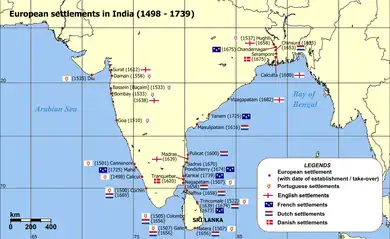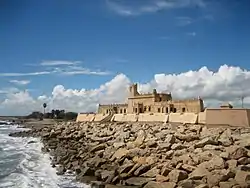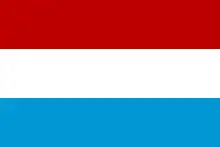Danish East India Company
The Danish East India Company[1] (Danish: Ostindisk Kompagni[2]) refers to two separate Danish-Norwegian chartered companies. The first company operated between 1616 and 1650. The second company existed between 1670 and 1729, however, in 1730 it was re-founded as the Asiatic Company (Danish: Asiatisk Kompagni).

First company

The first Danish East India Company was chartered in 1616 under King Christian IV and focused on trade with India. The first expedition, under Admiral Gjedde, took two years to reach Ceylon, losing more than half their crew. The island had been claimed by Portugal by the time they arrived but on 10 May 1620, a treaty was concluded with the Kingdom of Kandy and the foundation laid of a settlement at Trincomalee on the island's east coast.[3] They occupied the colossal Koneswaram temple in May 1620 to begin fortification of the peninsula before being expelled by the Portuguese.[4] After landing on the Indian mainland, a treaty was concluded with the ruler of the Tanjore Kingdom, Raghunatha Nayak, who gave the Danes possession of the town of Tranquebar, and permission to trade in the kingdom by treaty of 19 November 1620.[3] In Tranquebar they established Dansborg and installed Captain Crappe as the first governor (opperhoved) of Danish India.[5] The treaty was renewed on 30 July 1621, and afterwards renewed and confirmed on the 10 May 1676, by Shivaji the founder of the Maratha Empire.[3]
During their heyday, the Danish East India Company and Swedish East India Company imported more tea than the British East India Company, smuggling 90% of it into England, where it could be sold at a huge profit. Between 1624-36, Danish trade extended to Surat, Bengal, Java, and Borneo, with factories in Masulipatam, Surat, Balasore and at Java, but subsequent European wars in which Denmark participated ruined the Company, and trade in India ceased entirely between 1643–69, during which time all previous acquisitions were lost except Tranquebar, which held out until aid from Denmark arrived in 1669.[3]
Second company, and the Asiatic Company
In 1670, a second Danish East India Company was established, before it too was dissolved in 1729. In 1730, it was refounded as the Asiatic Company and opened trade with Qing China at Canton. The first expedition went badly, with Den gyldne Løve lost with its cargo of silver off Ballyheigue, Ireland, on the outbound journey. Local landowners held the silver at their estate and pursued a salvage claim, but a gang of locals overpowered the Danish guard and made off with the hoard, causing a diplomatic row between Denmark-Norway and Britain.[6] With the royal licence conferred in 1732, the new company was granted a 40-year monopoly on all Danish trade east of the Cape of Good Hope. Before 1750, it sent 27 ships; 22 survived the journey to return to Copenhagen.[6] In 1772, the company lost its monopoly and in 1779, Danish India became a crown colony.
During the Napoleonic Wars, in 1801 and again in 1807, the British Royal Navy attacked Copenhagen. As a consequence of the last attack (in which the entire Dano-Norwegian navy was captured), Denmark (one of few Western European countries not occupied by Napoleon), ceded the island of Heligoland (part of the Duchy of Holstein-Gottorp) to Britain. In the east, when news of Anglo-Danish hostilities reached India, the British immediately seized seven Danish merchant ships on 28 January 1808 that were in the Hoogli.[7] Denmark finally sold its remaining settlements in mainland India in 1845 and the Danish Gold Coast in 1850, both to the British.
Ships
- Kiøbenhavn and Christian (1618–1621, part of the Gjedde expedition that founded Dansborg at Tranquebar)[8]
- Christianshavn (8 November 1639, Willem Leyel left Denmark for Tranquebar as commander of this ship)[8]
- Flyvende Ulv (Departure from Copenhagen 1682 with Axel Juhl, who was appointed governor of Tranquebar later the same year. Departure from Copenhagen 1685 with Wollf Heinrich v. Calnein, governor of Tranquebar 1687)[9]
- Cron Printz Christian (Cron Printzen) and Den gyldne Løve (1730–31, the Tønder expedition that opened trade with China - Den gyldne Løve was shipwrecked in Ireland)
- Elephant(en) (1747–1750) The ship was lost on 15 August 1750 in "Mosele Bay", near the Cape of Good Hope. There were 35 survivors; they were rescued by Onwerkirk (
 Dutch Republic). Elephant was on a voyage from Tranquebar, India to Copenhagen.[10][11]
Dutch Republic). Elephant was on a voyage from Tranquebar, India to Copenhagen.[10][11] - Grev Moltke (1760, first Moravian missionaries)
- Nicobar Sunk 1783 with load of Swedish Plate Money.
- Disco (1778 ship), frigate built for the Danish navy and named for Disko Island, but transferred to Danish EIC before maiden voyage.[12][13]
- Hussar, purchased 1783.[14]
- Holsten (I), renamed from Det Store Bælt, declared unseaworthy and condemned at Mauritius in 1807[15]
- Holsten (II) purchased in 1806 from the French at Mauritius and renamed to replace Holsten (I).[16] Seized by the British (HMS Modeste (1793), HMS Terpsichore (1785) and HMS Dasher) on the Hooghly in January 1808.[17] Six other Danish ships were seized at the same time
See also
- Danish India
- Danish Mission College
- Tranquebar Mission
- Danish West India Company
- British East India Company
- Assada Company, English trading company, founded 1635 and ceased 1657
- Austrian East India Company, founded 1775 and ceased 1785
- Dutch East India Company, founded 1602 and ceased 1798
- French East India Company, founded 1664 and ceased 1769
- Portuguese East India Company, founded 1628 and ceased 1633
- Swedish East India Company, founded 1731 and ceased 1813
- List of trading companies
- Whampoa anchorage
References
- "The Danish East India Company". Archived from the original on 11 October 2007. Retrieved 12 April 2004.
- "Ostindisk Kompagni". Den Store Danske (Gyldendal) (in Danish). Retrieved 9 February 2020.
- The Bengal and Agra Annual Guide and Gazetteer. W. Rushton and Company. 1841. p. 415.
- Jensen, Uno Barner (1997). Danish East India, Trade Coins and the Coins of Tranquebar: 1620 - 1845. Barner Jensen. ISBN 9788798368236., pp. 11-12; Furber, Holden (1986). Imperi rivali nei mercati d'Oriente, 1600-1800. Il Mulino. ISBN 9788815011985., note n° 66, p. 326: "Senarat of Kandy sent to Trincomalee 60 Sinhala men in order to help the Danes in the construction of their fort. During their permanence in Trincomalee, the Danesh coined also some "Larins", on which were recorded the words 'Don Erich Grubbe', of these coins, today do not remain trace, if not in the diary of Ove Giedde."
- Foreningen Trankebar. "Artikel om en tur fra Chennai til Trankebar".
- Foreningen Trankebar. "Brev fra England".
- "No. 16982". The London Gazette. 7 February 1815. p. 219.
- The Trials and Travels of Willem Leyel: An Account of the Danish East India Company in Tranquebar, 1639-48
- "Enkeltskibsoplysninger FLYVENDE ULV / DEN FLYVENDE ULV / ULVEN". 14 December 2021.
- "The Marine List". Lloyd's List. No. 1595. Lloyd's of London. 12 March 1750.
- "The Marine List". Lloyd's List. No. 1597. Lloyd's of London. 19 March 1750.
- Marcussen - Disco
- Royal Danish Navy Museum - List of ships - Disco
- Lloyd's Register (1784), Seq. №H343.]
- Marcussen - Holsten (I) record card
- Marcussen - Holsten (II) record card
- London Gazette Issue 16982 Page 219 dated 7 February 1815
.svg.png.webp)